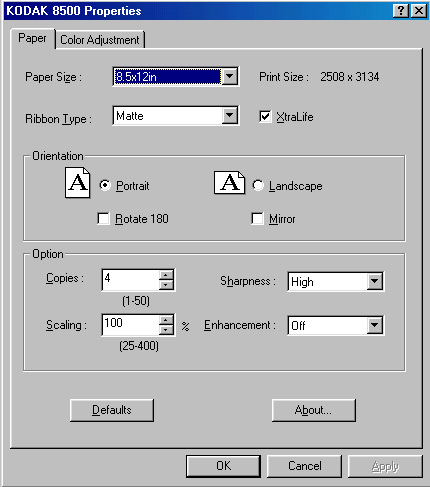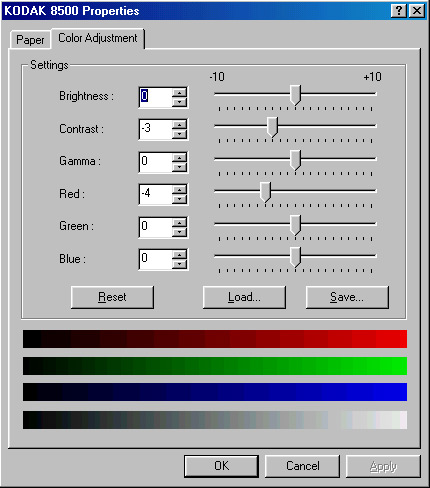Best
viewed at 1024 x 768 or greater screen resolution,
16 bit color or better.
All content & photographs copyrighted, all
rights reserved.
The Kodak 8500 Thermal Dye Sublimation Photo Printer
(Now discontinued)
I switched from
inkjets to dye-sub printers in early 1999 and have
been totally satisfied with my prints ever since.
In my opinion, once you've experienced the
appearance, feel, finish, durability, and quality
you get from a dye-sub printer, you'll never be
satisfied with anything less. The new Kodak 8500
has brought the price of owning a full-sized
dye-sub printer down to a level where every pro
shooter and serious digital photography enthusiast
should have one.
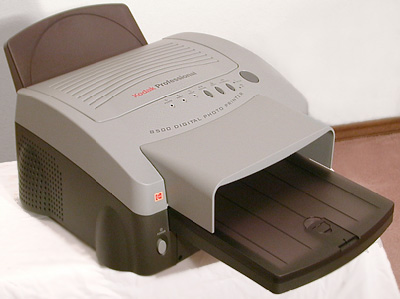
Printer Overview
- Continuous tone dye-sublimation (thermal dye diffusion) true photo-quality printer capable of finished prints up to 8" x 10".
- Image print quality: Ten on a scale of 1-10. (Yes, it's really that good.)
- Gloss prints: The gloss prints have a satin-like gloss to them, not too reflective and not too glossy. The finish is extremely durable, equal or better in quality to the best lab processed prints you've ever seen. Extremely pleasing to the eye and touch.
- Matte prints: Have a slightly textured surface with no gloss, and can give a greater sense of natural depth for certain pictures. (I like them for portraits & night scenes.) Matte prints have their place for permanent display behind glass, but are generally not suitable for everyday handling because of the nature of the flat finish. Behind-glass mounting is recommended because the matte finish scratches easily, as does any flat coating.
- Connection / Interface: USB or Parallel Port, Windows or Mac.
- Software: Windows & Mac drivers, a full printable manual on CD, and a full version of Adobe Photoshop "Elements" software.
- Not included: Paper, print ribbons, USB or Parallel cables.
- Print speed: 55 seconds to spool up an 8x10 print on my USB cable-connected Windows 98SE based 1 Gig Pentium III with 512 MB of Ram, plus 70 seconds actual print time. Total time from "click" to "done" 125 seconds.
- Total length front to back, 26 1/2". Total width 17". Total height 10 1/2". (Measurements are with all trays & covers installed, include the space taken by bulges, curves, & extensions.)
- Total actual working weight is approximately 35 lbs., including the print ribbon and a full load of paper.
- Overall build quality: I'll give it another 10 on a 10 scale. This is a fine piece of equipment.
- And it's quiet... very smooth & very quiet. Annoyance factor "zero".
How does it work?
The Kodak 8500
printer uses a plastic film transfer ribbon made up
of a continuous series of transparent yellow,
magenta, cyan, and clear page-sized panels.
The yellow,
magenta, and cyan combination reproduces natural
color by means of the subtractive
color printing
process.
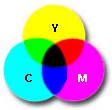
Subtractive Color
Process
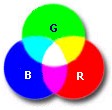
Additive Color
Process
A page-wide thermal print head, consisting of thousands of tiny heating elements capable of precise temperature variations, reacts with the colored dyes in the ribbon. The heat causes the dye to vaporize from the ribbon and diffuse onto the surface of the specially coated paper. The hotter the heating element, the more dye is vaporized and the denser the color application. Precise temperature variations in the tiny heating elements are responsible for the variations in color.
The printer automatically cycles the paper through the printer four times, moving it back & forth as the thermal print head applies the colors from the different panels of the moving ribbon one by one, the fourth pass being a clear UV resistant protective gloss or matte coating. The result of the total printing process is a long-lasting, extremely durable, continuous tone, true photo-quality color print.
Paper supply
The paper tray
holds 50 sheets of paper. The paper comes 100
sheets to a box, each box contains two 50 sheet
packages. The printer uses
the same paper for matte or gloss prints, the
difference between gloss & matte output comes
from using two different types of print ribbons.
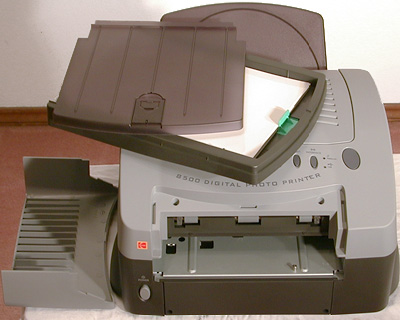
Paper sizes & output
- Paper is available in three sizes: 8 1/2" x 11", 8 1/2" x 12" and A4.
- Important: The printer uses 1" of the top & bottom of a page and 1/4" on each side of the page for its print feed mechanism. Therefore the maximum print area using 8 1/2" x 11" paper is 8" x 9", and the 8 1/2" x 12" and A4 paper has a maximum print area of 8" x 10".
Top control
panel & print ribbon compartment The big button on
the right opens the print ribbon access cover.
The other three
buttons control: Indicator lights
show power on or off, printer error warning, and
paper out warning. Print ribbon
& carrier A new ribbon will
print 50 pages, the same capacity as the paper
tray. Like the paper, the
ribbons come in 100 print packs, each package
contains two boxes of 50 print ribbons. The color ribbon is
made up of sequential sections of yellow, magenta,
cyan, and clear.
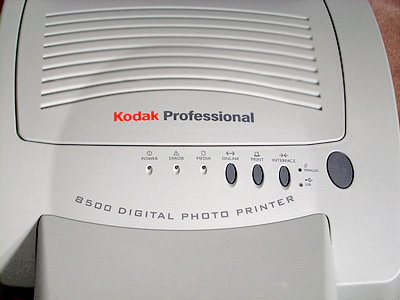
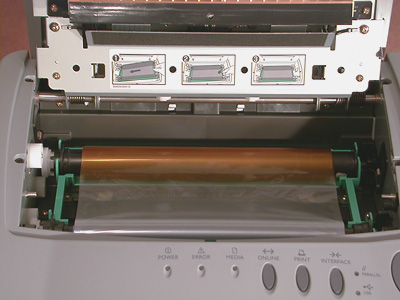
Print Ribbons
If you print both gloss and matte, you don't need to change paper, just the print ribbon. In order to print both gloss and matte finishes, two ribbon packs are required (one gloss, one matte).
- The gloss ribbon applies a final coat of semi-gloss clear.
- The matte ribbon applies a final matte (non-reflective) clear coat.
- Changing or replacing a ribbon pack is simple. The ribbon carrier lifts out of the top of the printer, and the double spooled ribbon pack snaps out of the carrier.
- Ribbons can be swapped or replaced at any time by simply popping up the top cover, lifting out the ribbon carrier, and changing out the ribbon spool set. (Very similar to changing out the fax ribbon on certain brands of fax machines.)
- Ribbons can only be used once, because the impression of each print is permanently etched into the ribbon as it transfers the dye to the paper. (Repeat use would produce blank or ghosted areas.)
- The same ribbon is used for all sizes (8 1/2" x 11", 8 1/2" x 12", or A4) paper.
The print process
First
pass Pictured at left is
the first pass through the printer, shown just as
it finished applying the yellow section of the
print ribbon and began pulling itself back into the
print body to start the second color
pass. Second
pass The second pass
applies the magenta section of the three color
print ribbon. Third
pass This time with the
cyan section of the three color ribbon. The yellow,
magenta, and cyan passes are combined into a full
color, continuous tone image. The color
application is now complete. Fourth &
final pass The fourth pass
applies either the gloss or matte finish UV
resistant clearcoat and ejects the print from the
printer. The print process
is complete. The print can be
handled immediately, there is no "drying"
time.
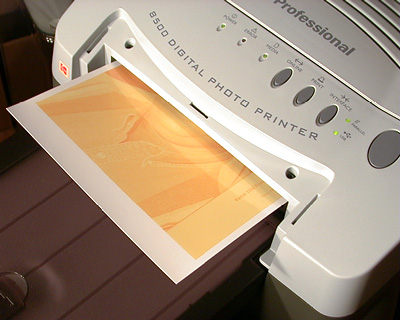
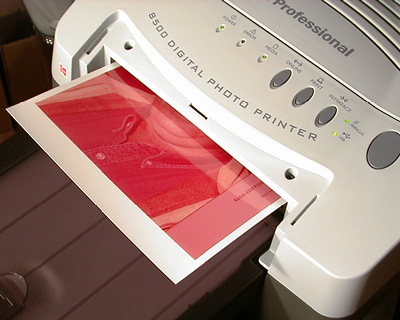
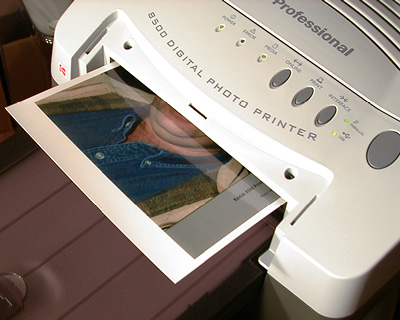
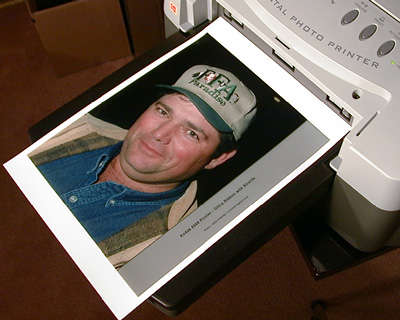
Windows Printer Software Screenshots
Print property
adjustments, page 1. In most cases, I've
found that the "High" print sharpening setting
produces the best quality prints, faithfully
reproducing original on-screen
sharpness. The "XtraLife" is
the fourth pass, which is the clear gloss or matte
finish final coating. It also serves as a UV light
barrier. Print property
adjustments, page 2. For my setup, I
found that a small tweak to the red & contrast
settings produced virtually perfect color and tone
reproduction.
